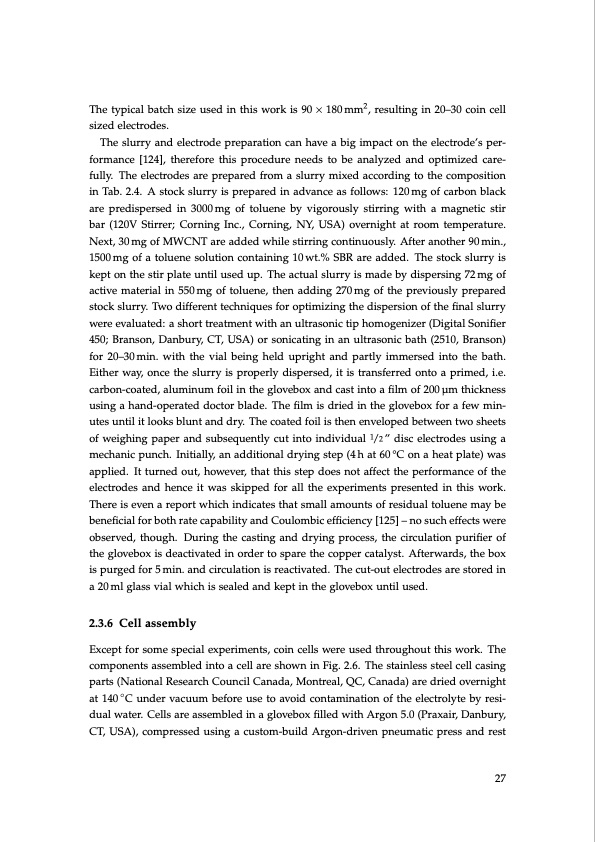
PDF Publication Title:
Text from PDF Page: 027
The typical batch size used in this work is 90 × 180 mm2, resulting in 20–30 coin cell sized electrodes. The slurry and electrode preparation can have a big impact on the electrode’s per- formance [124], therefore this procedure needs to be analyzed and optimized care- fully. The electrodes are prepared from a slurry mixed according to the composition in Tab. 2.4. A stock slurry is prepared in advance as follows: 120 mg of carbon black are predispersed in 3000mg of toluene by vigorously stirring with a magnetic stir bar (120V Stirrer; Corning Inc., Corning, NY, USA) overnight at room temperature. Next, 30 mg of MWCNT are added while stirring continuously. After another 90 min., 1500 mg of a toluene solution containing 10 wt.% SBR are added. The stock slurry is kept on the stir plate until used up. The actual slurry is made by dispersing 72 mg of active material in 550 mg of toluene, then adding 270 mg of the previously prepared stock slurry. Two different techniques for optimizing the dispersion of the final slurry were evaluated: a short treatment with an ultrasonic tip homogenizer (Digital Sonifier 450; Branson, Danbury, CT, USA) or sonicating in an ultrasonic bath (2510, Branson) for 20–30 min. with the vial being held upright and partly immersed into the bath. Either way, once the slurry is properly dispersed, it is transferred onto a primed, i.e. carbon-coated, aluminum foil in the glovebox and cast into a film of 200 μm thickness using a hand-operated doctor blade. The film is dried in the glovebox for a few min- utes until it looks blunt and dry. The coated foil is then enveloped between two sheets of weighing paper and subsequently cut into individual 1/2 ” disc electrodes using a mechanic punch. Initially, an additional drying step (4 h at 60 °C on a heat plate) was applied. It turned out, however, that this step does not affect the performance of the electrodes and hence it was skipped for all the experiments presented in this work. There is even a report which indicates that small amounts of residual toluene may be beneficial for both rate capability and Coulombic efficiency [125] – no such effects were observed, though. During the casting and drying process, the circulation purifier of the glovebox is deactivated in order to spare the copper catalyst. Afterwards, the box is purged for 5 min. and circulation is reactivated. The cut-out electrodes are stored in a 20 ml glass vial which is sealed and kept in the glovebox until used. 2.3.6 Cell assembly Except for some special experiments, coin cells were used throughout this work. The components assembled into a cell are shown in Fig. 2.6. The stainless steel cell casing parts (National Research Council Canada, Montreal, QC, Canada) are dried overnight at 140◦C under vacuum before use to avoid contamination of the electrolyte by resi- dual water. Cells are assembled in a glovebox filled with Argon 5.0 (Praxair, Danbury, CT, USA), compressed using a custom-build Argon-driven pneumatic press and rest 27PDF Image | Lithium-Sulfur Battery: Design, Characterization, and Physically-based Modeling

PDF Search Title:
Lithium-Sulfur Battery: Design, Characterization, and Physically-based ModelingOriginal File Name Searched:
Dissertation_David_N._Fronczek_The_Lithium_Sulfur_Battery.pdfDIY PDF Search: Google It | Yahoo | Bing
Sulfur Deposition on Carbon Nanofibers using Supercritical CO2 Sulfur Deposition on Carbon Nanofibers using Supercritical CO2. Gamma sulfur also known as mother of pearl sulfur and nacreous sulfur... More Info
CO2 Organic Rankine Cycle Experimenter Platform The supercritical CO2 phase change system is both a heat pump and organic rankine cycle which can be used for those purposes and as a supercritical extractor for advanced subcritical and supercritical extraction technology. Uses include producing nanoparticles, precious metal CO2 extraction, lithium battery recycling, and other applications... More Info
| CONTACT TEL: 608-238-6001 Email: greg@infinityturbine.com | RSS | AMP |